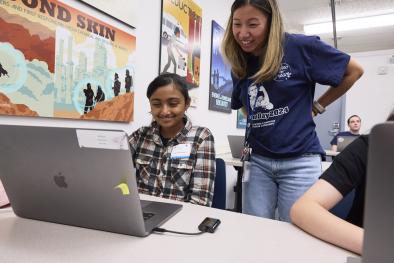On May 10, 52 Livermore middle schoolers arrived at the Lab for Dream Day, a first-of-its-kind computer science outreach event. The students—all members of Girls Who Code programs at their respective schools—completed a number of hands-on lab activities, and received an introduction to Lawrence Livermore.
Dream Day took place at the Livermore Valley Open Campus and Discovery Center, where students from five middle schools shared in the dreams of organizers Paige Jones and Mariah Martinez, who work in Computing's Enterprise Application Services division. Though the Lab hosts many outreach events already, Jones and Martinez aimed to create one focused on computer science.
“We wanted something that could showcase things that we do at the Lab in a fun and engaging way, because a lot of the time, kids don’t understand exactly how computer science is applied,” explains Martinez. “There are careers in cyber security doing really interesting things, careers creating websites, careers where you can actually work with scientists and engineers. We just wanted to show that we have a lot of fun in all these cool, different areas.”
Martinez and Jones say that most people imagine a career in tech to be isolated and lonely. To combat this notion, they designed projects for the students that demonstrate the types of collaborative environments real computer scientists work in.
One activity involved role playing as special agents to decrypt important messages about how to acquire snacks. The messages were encoded with different types of ciphers, and the students learned about which data might be encrypted in the real world, and why. In another activity, participants made paper helicopters, and used conductive copper tape to build a basic circuit to light up their creations with LEDs. They discussed how this circuit is similar to the chips in their laptops and phones, albeit on a much smaller scale. The students also dabbled in web design with a brief introduction to basic HTML, CSS, and Bootstrap, and put together their own basic webpages.
“With these activities, we’re able to show them a little taste of what we do at the Lab, and that makes a huge difference,” Martinez says.
Both Martinez and Jones are Girls Who Code club leaders, and the two have worked together on other outreach efforts in the past, including STEM Day and Altamont Connection. They hope to expand Dream Day into a twice-yearly event that involves club members from Tracy schools as well.
“Broadening our outreach to students at this age is really important, because it sets a path and opens a door that we never had,” says Jones. She emphasizes the need to introduce girls to STEM careers—including computing careers—at a young age to develop a bond and keep their interest alive.
“Providing opportunities for the Girls Who Code students to come to the Lab and see where their mentors work is the next step in the pipeline to keep them engaged and excited about science,” adds Joanna Albala, who manages the Lab’s Science Education Program.
—Anashe Bandari


